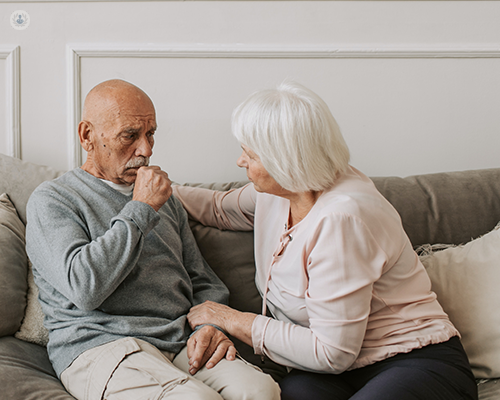All about COPD (chronic obstructive pulmonary disease)
Autore:COPD (chronic obstructive pulmonary disease) is a progressive lung condition that causes breathing difficulties due to airflow obstruction and inflammation.
Here, Dr Edward Cetti, renowned consultant respiratory physician, offers expert insights into COPD, including the symptoms, the diagnosis and the available treatment options for the condition.

What are the main causes of COPD?
Over 90 per cent of patients who are diagnosed with COPD in the UK have developed the condition as a consequence of directly smoking tobacco. Often, this is at least one pack of cigarettes a day for 10 years.
Not everyone who smokes this amount goes on to develop COPD, however - largely due to genetic factors.
In the small group of patients who develop COPD without smoking a lot, it is often difficult to find the exact cause and it is probably due to a combination of factors that add up to increase their risk for COPD. Again, genetic susceptibilities may play a role.
Other causes of COPD include passive smoking in childhood or even in the womb as a foetus and exposure to certain industrial toxins.
What are the symptoms of COPD, and how do they progress?
The main symptom of COPD is breathlessness, which may start on exertion only and gradually progress over months and years.
For example, you may start feeling slightly short of breath taking the stairs or walking up a hill, and then gradually progress from that point. For some patients, if the process carries on developing, they may become breathless walking very short distances or even walking from room to room at home.
Once breathlessness develops due to COPD, treatment can help manage it, but it doesn’t completely resolve it. Patients who have COPD live with a degree of breathlessness every day, which may worsen in the event of a chest infection, and usually gets worse over the years. This is very different from the symptoms of asthma, when there are periods of breathlessness interspersed by periods where there aren't any symptoms at all.
Another possible symptom of COPD is a cough productive of sputum or phlegm, particularly in the morning. The cough may be the first symptom that appears. Often, however, it is put down as just a smoker’s cough, when actually it should be a real red flag because it is a sign of developing chronic bronchitis, which is a part of COPD.
Other symptoms include chest tightness, wheezing, fatigue, and weight loss or weight gain/fluid retention in some patients.
Another feature of COPD can be a tendency to get chest infections with cough and phlegm. These infections may happen after a cold and will often need treatment with antibiotics.
How is COPD diagnosed?
If you have symptoms of COPD, it is important to go see a GP or a respiratory specialist, particularly if you have a history of smoking. Even if you gave up smoking years ago, the symptoms of COPD can start many years after having quit.
COPD is diagnosed by taking a medical history, trying to determine the pattern of symptoms. A specialist may ask: When did the symptoms start? Did you have symptoms years ago, maybe when you were a child, that were never diagnosed? Or, on the contrary, did all these symptoms start in adult life?
The main diagnostic test for COPD is a lung function test called spirometry. Spirometry measures the volume of air you can blow out over time during a forced expiration. In people who have COPD, spirometry can help identify a reduction in the flow of air out of the lungs, called airflow obstruction.
A chest X-ray is ordered to check for other possible causes and look for subtle changes in the lungs.
Asthma is another possible cause of airflow obstruction and telling the two conditions apart can be quite tricky in some cases. The differentiation between the two conditions will rest on the pattern of symptoms, the age of onset, how variable the symptoms are, and if there are any changes in the lung function test.
What are the available treatments and management options for COPD?
The most important management option is quitting smoking as soon as possible. Continuing to smoke speeds up the progression of COPD and makes other treatments less effective.
There is a lot of support available to increase the chances of successfully quitting, in terms of nicotine replacement or medications. Some patients find vaping as an alternative, but again, vaping isn’t completely safe but is useful temporarily as a way of coming off cigarettes.
There are other supportive or preventive treatment options available which are really important. For example, when you have COPD, you are eligible for and will really benefit from the annual influenza and COVID vaccination.
Any type of aerobic exercise regularly during the week will really help keep your lungs healthy, be that cycling, walking, swimming or an exercise bike. There are supervised physiotherapy programs with exercises designed for patients who have COPD, called pulmonary rehabilitation, and a specialist can refer you for those.
In terms of medications, the hallmark for treating COPD are inhalers. There are different medications in inhalers and different types of inhalers, but it depends a little bit on the particular pattern of COPD. There are different patterns. Some patients have breathlessness, but never have cough or phlegm, and aren't really troubled by chest infections. Other patients, on the other hand, have a lot of cough and phlegm, with frequent chest infections.
Some patients who have COPD have quite asthmatic type of features, seen in the pattern of their symptoms and sometimes the results of a blood test. There are specific types of inhalers for this group of patients.
For patients who develop severe COPD, when blood oxygen level or oxygen saturations become persistently low, having oxygen at home or lightweight oxygen when they are walking can really improve how they feel, their ability to walk, and their clinical outcomes.
For patients who develop really severe COPD, particularly when their pattern of symptoms is more emphysema (damaged air sacs) than bronchitis, there are surgical options available such as lung volume reduction surgery or minimally invasive alternatives such as endobronchial valve placement. These can significantly improve breathlessness, and a respiratory specialist can assess you for those.
Are there lifestyle changes or habits that can help improve COPD symptoms?
I have mentioned a few already:
- Stopping smoking and vaping
- Keeping active
Aerobic exercise won’t harm you. If you do get breathless, you can stop and recover, and then continue.
- Trying to maintain a healthy body weight
For patients who have a low BMI and who have lost weight, trying to maintain a healthy body weight by increasing their calorie input is helpful. This includes eating high calorie chocolate, full fat milk, and keeping up with fruit and vegetable intake.
For patients who have a high BMI and who have put on weight or have fluid retention, trying to maintain a healthy body weight by eating a balanced diet is helpful.
There are no other particular lifestyle changes. It is all about quitting smoking, regular exercise, and a balanced diet.
If you require expert diagnosis and treatment for COPD, don’t hesitate to book a consultation with Dr Edward Cetti via his Top Doctors profile today.


